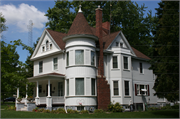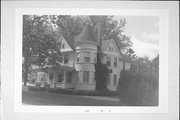| Additional Information: | 2 STORY TOWER W/ CONICAL ROOF ON CNR2 STORY BAY ON SIDEPALLADIAN WINDOW IN FRONT GABLE
2013 New Holstein Survey results:
Built circa 1902, this two-and-one-half-story house is an example of the transition between the Queen Anne and Colonial Revival styles of architecture. The primary Queen Anne feature is the home’s two-and-one-half-story tower, while the simple wooden porch columns and the Palladian window in the gabled peak are representative of the Colonial Revival style. At some point after 1915, an exterior brick chimney (and likely an interior fireplace) was added to the house (likely in the 1920s). Additional alterations to the home include a number of new windows, as well as the application of vinyl and board and batten siding (replacing the original clapboard and fish scale shinglework).
This house was designed by Sheboygan architect Charles Hilpertshauser and built for Alfred T. & Mary Hipke circa 1902. Alfred Hipke was born in 1873 in the Town of Schleswig, Manitowoc County. In 1899, he established the New Holstein Canning Company, which, as of 1936, bore his name—A.T. Hipke & Sons, Inc. Hipke served as the president of the Wisconsin Pea Canners Association in 1916, 1917 and 1918 and, the following year, he was the first president of the newly formed New Holstein Association of Commerce, which is still active today. That same year, he and Henry Lauson contributed the funds necessary to build the first refreshment stand in the newly established Civic Park. In the late-1920s, Alfred started Hipke Orchards west of New Holstein. He is also identified as having been the first to do contoured and stripped crop farming in eastern Wisconsin and he was a pioneer in fighting tuberculosis in dairy herds. He and his wife remained in the family home until their respective deaths in 1960 and 1942. |
|---|
| Bibliographic References: | Historic image in "New Holstein: Land of Peace and Plenty," (1915), page 13, photo #3.
Charles Hilpertshauser, “Residence for Alfred F. Hipke [sic],” Original drawings, Not dated, On file at the Wisconsin Architectural Archive, Milwaukee Public (Central) Library, Milwaukee, WI; Rud Puchner to Alfred T. Hipke, Warranty Deeds, 2 May 1901 and 11 December 1902, 31/599 and 33/332, respectively; “Specifications for the A.T. Hipke House” written by Charles Hilpertshauser, dated 26 May 1902 are in possession of the New Holstein Historical Society; “A.T. Hipke Honored,” Calumet County Reporter, 10 December 1915, 1/6; “A.T. Hipke: Pioneer Wisconsin Canner,” in Food Packer (November 1954), 24; “A.T. Hipke Dead At 87 in New Holstein,” The Sheboygan Press, 24 August 1960, 16; Newsbrief (re: refreshment stand in park), Calumet County Reporter, 16 May 1919, 1/5; “Association of Commerce” and “A.T. Hipke & Sons, Inc.” in New Holstein Centennial Souvenir Booklet, n.p. |
|---|


